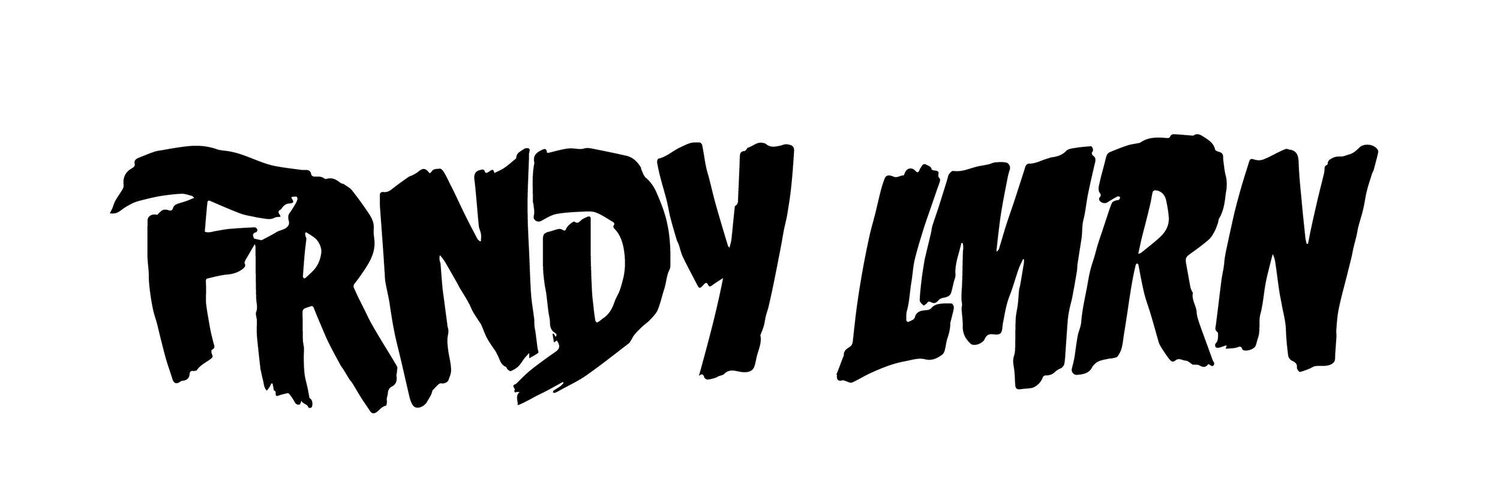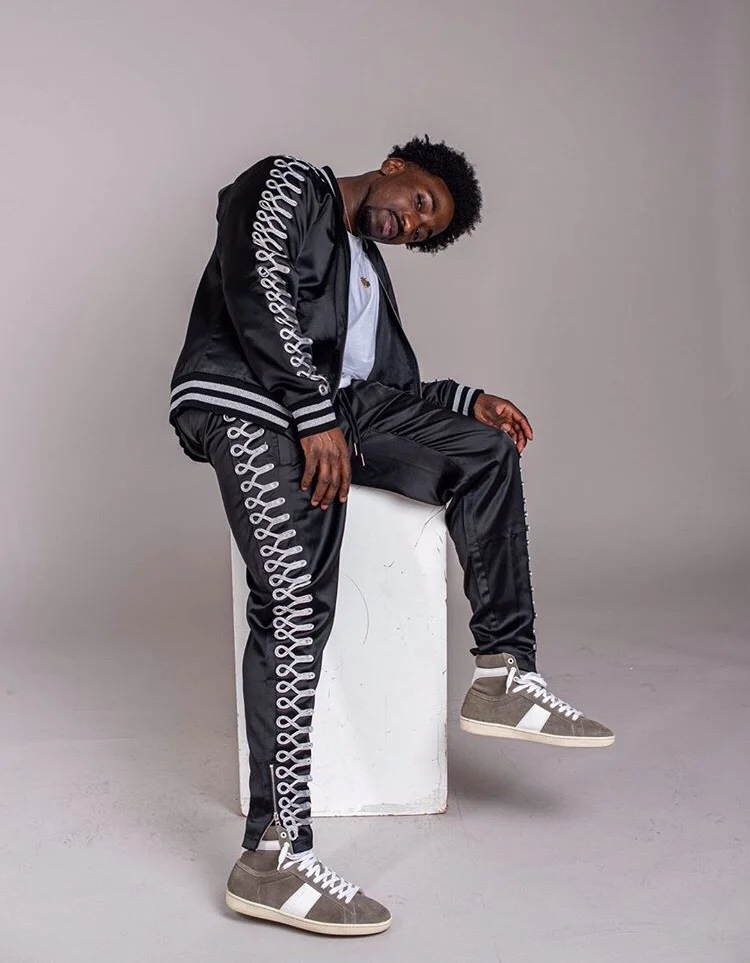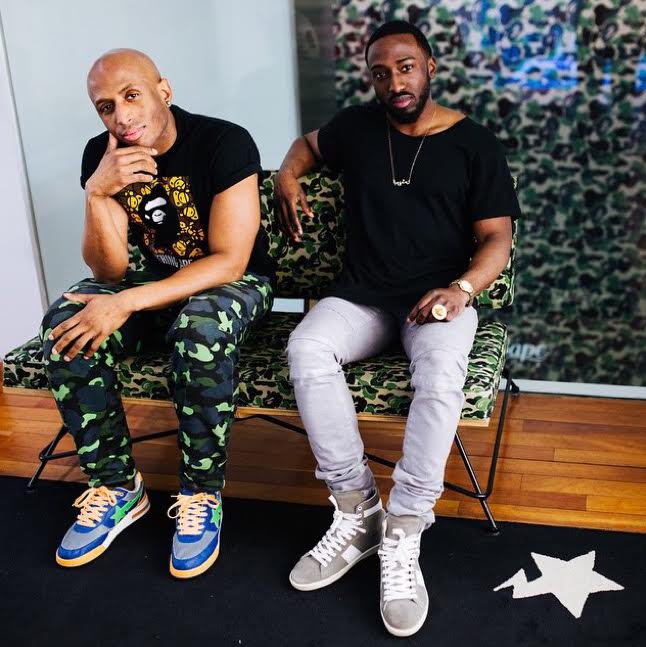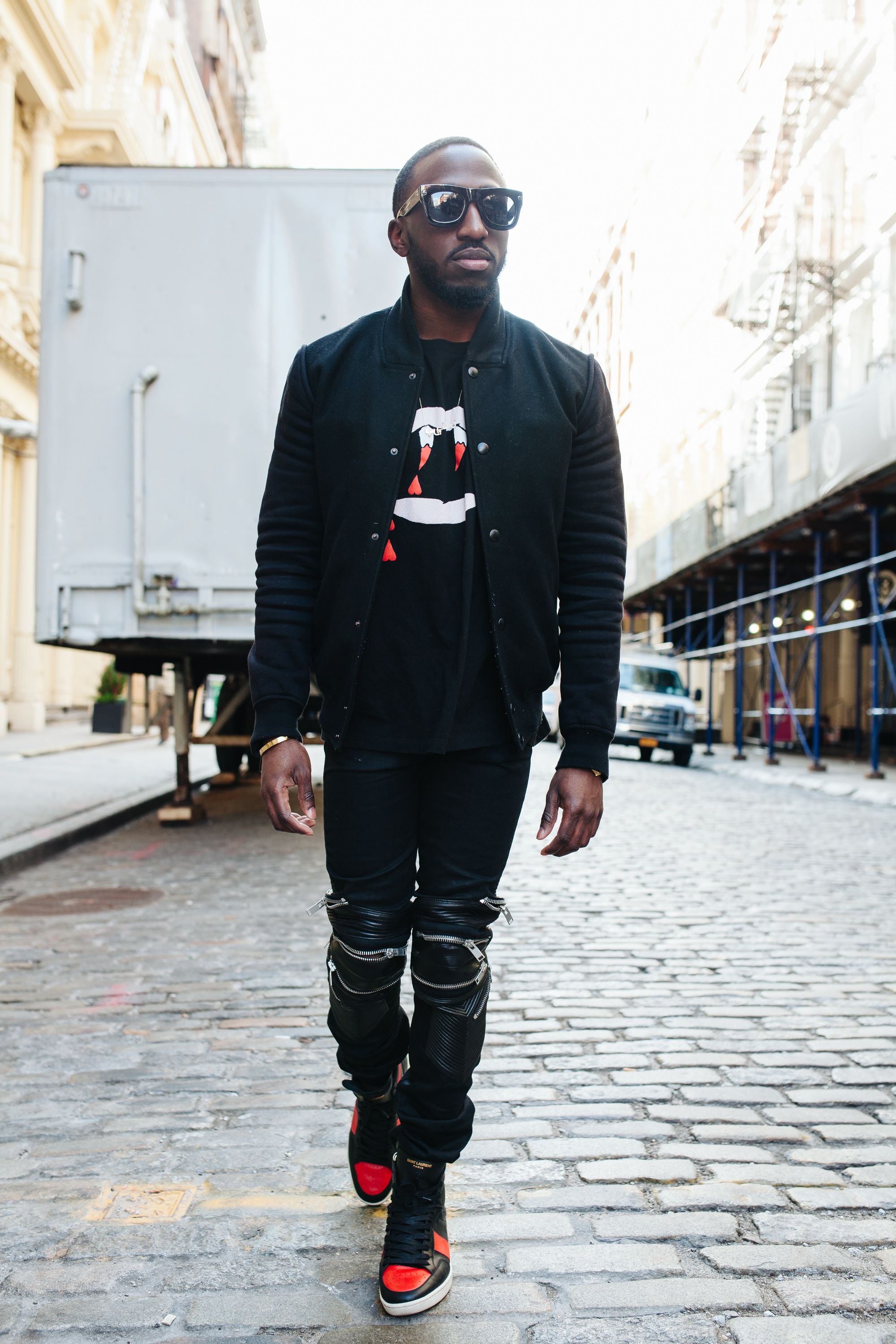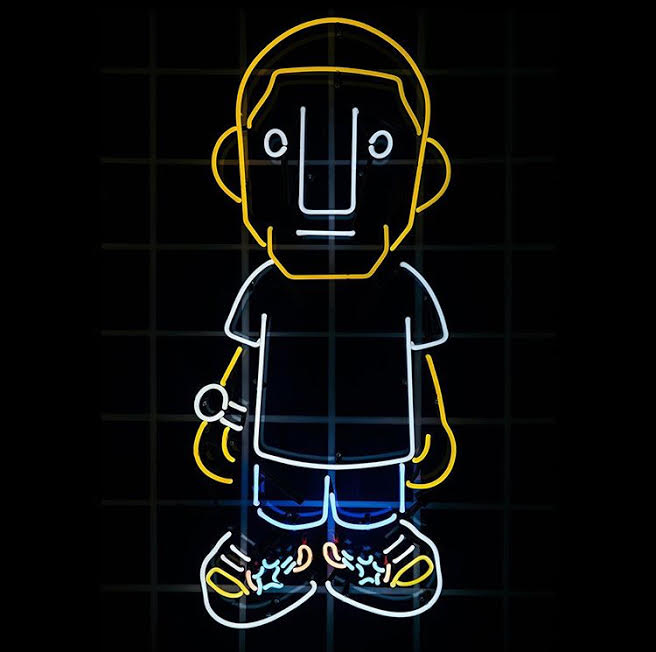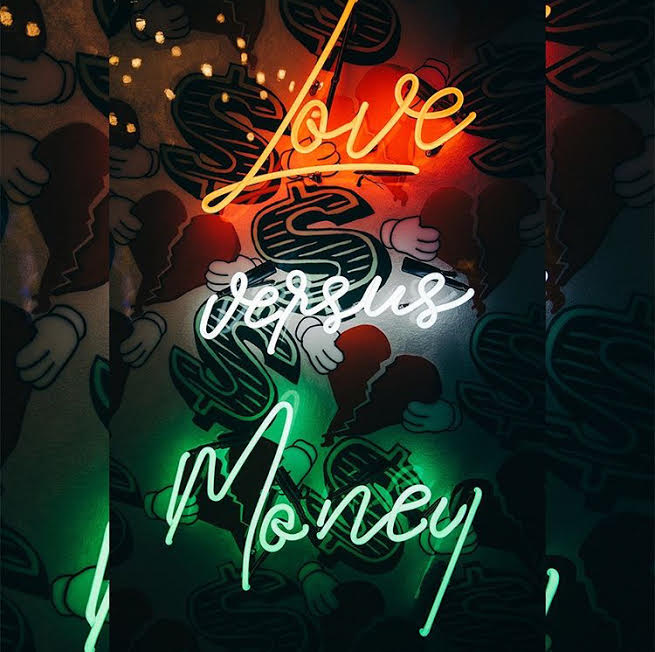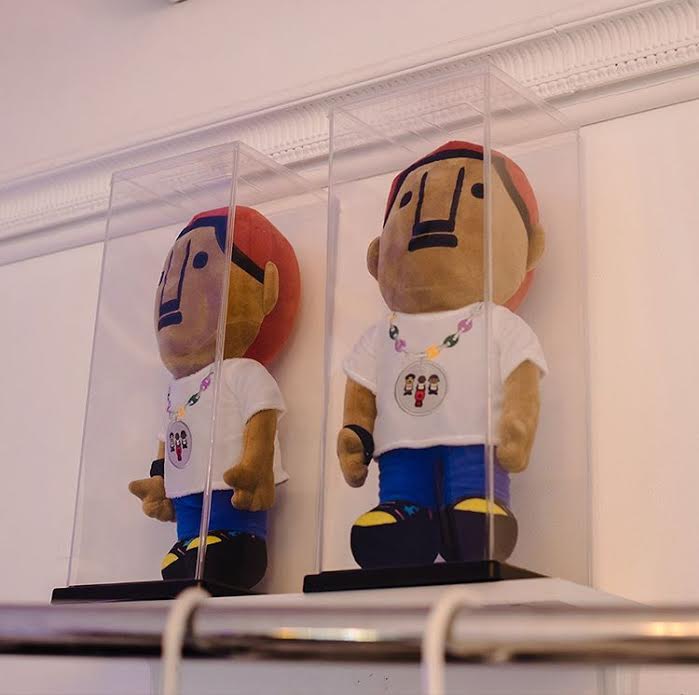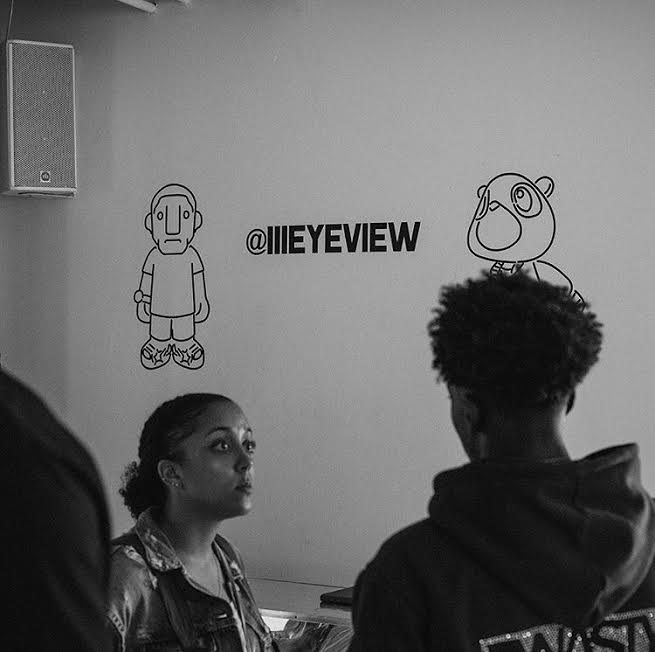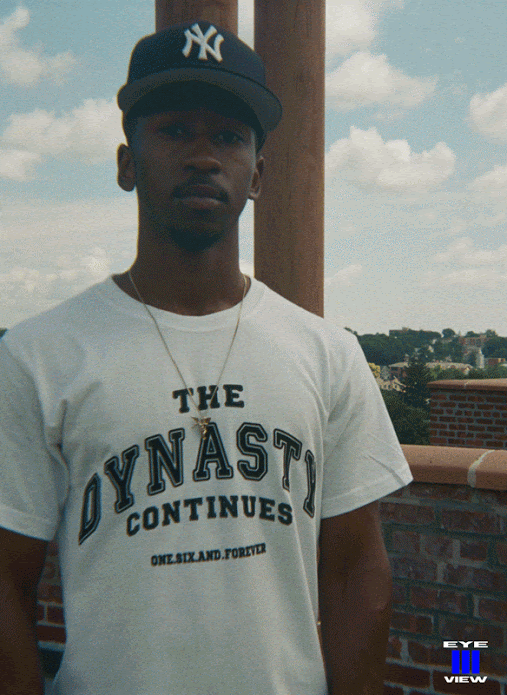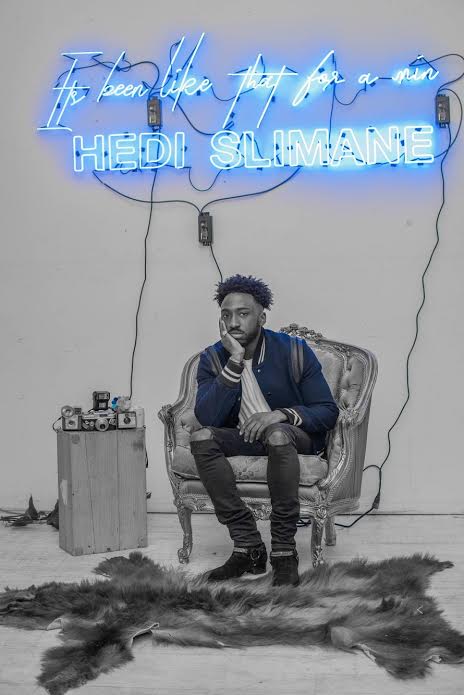The Thiiird
Throughout my nearly nine-year stay at BAPE, I’ve encountered a vast array of personalities who taught me so much about myself and various aspects of life. A few “bad” apples, but for the most part, I formed long-lasting relationships with individuals who remained sturdier than 2 Milly dancing at a poppin’ Brooklyn basement party. Robert Owusu III is a member of this elite group.
Although he wasn’t a regular shopper, the fashionable Yonkers, New York native would stop by Nigo’s former shop on the release dates of our most exclusive pieces. It was during those times we were able to chat about life and practically everything else in between. Despite having a neck-breaking drip, Rob’s most defining trait is his sincerity. “A lot of people think I’m from another borough based on how I carry myself,” he humbly says. “I enjoy the fact that nobody can never guess that.”
Recently, Owusu—also known as “The Thiiird”—and I reconnected in person after four years at his In My Miiind art exhibit which paid homage to “the nostalgic space and times that birthed a generation of creatives and dreamers.” Which particular period of time you might ask? It is the era of 2006 through 2010, where the incomparable tandem of Pharrell Williams and Kanye West influenced an entire generation to become the “freaks and geeks” they truly are. Rob’s presentation was so inspiring, I had no other choice but to showcase his genius on this #FrendyOriginals series.
Check out the transcript of my sit-down with The Thiiird, as we discussed Skateboard P and Ye’s undeniable influence in pop culture, his childhood years in Yonkers, fashion, and artistic endeavors.
FRENDY: My man, Rob. I’m really looking forward to the gems that are about to be dropped in our talk.
ROB: First and foremost, thank you for interviewing me. We’ve known each other in passing since the BAPE days. It’s ironic that we are doing things creatively and linked up on the same frequency. Always been a genuine person so I thank you for that.
FRENDY: The pleasure is all mine. You revealed earlier that you were actually born in Harlem. When did you move to Yonkers?
ROB: Yeah, my family moved to Yonkers when I was about two years old. Like DMX said: “home of the brave, baby. Home of the brave.”
FRENDY: Those who are uninformed would assume that people from “the backyard of the Bronx” are mean, rugged, and just straight up grimey *Laughs*. You’re the total opposite of that stereotype.
ROB: I mean, Yonkers is the lost borough. It still gets real in the field out there, but it isn’t the way it used to be. Yonkers is a place where unity isn’t practiced since most have a “crabs in a barrel” mentality and everyone wants to be “the man”. But now things are starting to change and there are a few who are leading the pack. You have DJ Steph Cakes, who recently opened for Meek’s Motivational Tour, you have Iman who is doing songs with The Lox, Rondon doing beats for HighBridge, Sav The Genius, Prada Mama, and more.
FRENDY: How was it like growing up in Yonkers? Were your parents strict?
ROB: Growing up in Yonkers was the average ghetto story. The normal: parents trying to make a living for my brother (Brandon) and I, keeping us out of trouble in the best way possible. They also instilled principles and morals within us that we still carry on till this day. My parents are from Ghana and they were NOT lenient. I’m sure if you ask anybody whose parents are from a third world country would say the same *Laughs *. But they did the best that they possibly could for Brandon and I.
FRENDY: Did you experience any sort of hardships in school?
ROB: I would say one of the hardships in school was finding friends that shared similar interests as me. I had a few close friends though. Looking back, I’ve realized that my gift was being able to relate to all different types of people. I had honors classes with the smart kids, Spanish community embraced me, the hood dudes messed with me by default. I don’t judge anyone and do not care about status or race—I believe that’s how the world should rotate. Slowly but surely.
FRENDY: Same here, I’ve always had the ideology that we’re all one. When did you start caring about your aesthetics and such?
ROB: I started very young. I started caring about clothing and my appearance in fifth grade. My cousins would put me on to what was cool and what wasn’t. One of my cousins, Trisha, lived in the Bronx and she had EVERYTHING. We would travel there to just observe and bring the swag back to Yonkers.
I started taking my style seriously once I found out about SoHo—thanks to Pharrell wearing BAPE. I was mesmerized by the Bapestas he wore in Jay-Z’s 2004 documentary, Fade To Black. Once I found out that BAPE had a store in New York, things only snowballed from there.
FRENDY: Yeah, when I was informed that Nigo opened up a store in New York, I knew I was supposed to work there. It took a few years, but my dream came true! Do you remember your very first purchase from The Busy Workshop (BAPE’s old moniker)?
ROB: Of course, like it was yesterday! My father took me. It was my first $200 sneakers at the time. I was in middle school so this was around 2004-05. The beginning of a big spending habit *Laughs*. I had to beg him to take me. This was when I would get lunch money. I literally saved up $2.00-$3.00 religiously. I believe I was a few dollars short and my father spotted me since he saw how determined I was to purchase them. From the aesthetics of the store to the consumers coming in, I knew this was where I belonged.
FRENDY: Crazy. Were you the first person in your hood with Bapestas during that time? If so, that’s legendary status *Laughs*.
ROB: At this point, Stas started to get popular with [rapper] Cassidy having it in his videos and etc. There were a lot of fakes floating around. Maybe not the first, but I was probably the youngest to my knowledge.
The only person I knew with an authentic pair was my close friend Sway who I met my freshman year of high school. I gained his respect on being that young with the style I had. We literally learned the streetwear game together. From then on, we started bonding off of similar interests and did campouts. We were the ONLY people from Yonkers on all the lines. We had to stick together.
FRENDY: Funny how fashion can bring people together. I was initially drawn to Pharrell and Kanye’s artistry because they were winning by simply being themselves during a time where gangster rap was dominant. I’m sure you were intrigued by them for the same reason.
ROB: Exactly. Coming from where I'm from, we’re only exposed to so much. I thrived off of anything that was different from all spectrums. From fashion, music, and art, these were the figures who were being themselves and still had the ability to thrive in hip-hop. To finally find an area [SoHo] where I stumbled upon kids who looked like me—I felt like I found my nirvana.
FRENDY: The two albums that changed your life are Skateboard P’s debut solo album, In My Mind, and Kanye’s third project, Graduation. Why were those two so monumental for you instead of their earlier works?
ROB: Oh man! Those two projects were like a breath of fresh air sonically, never mind the backpack luxury bars. Rap has always been this boastful, rambunctious art form, but the way they put it together was entirely different.
I wasn’t around during the time of De La Soul or A Tribe Called Quest, but their music stands the test of time. It’s no surprise that they are the influence of Pharrell and Ye’s music. I literally lived In My Mind that summer when it dropped in July. I played the album EVERY…SINGLE...DAY.
Graduation was the first album that I didn’t want to hear not one leaked song until it came out. I think “Barry Bonds” leaked and I had to literally keep away from the computer and radio to prevent from hearing any song from it. I’m glad I did that because when I first heard the album from top to bottom, it took me to utopia. I couldn’t get past “Good Morning.” The fact that music can have such an impact on us is really beyond me. Both of their earlier works played a significant role in my life as well and seeing the growth, but those two projects was the “baby boom” of our era.
FRENDY: I feel you. You know what’s strange, P felt In My Mind was a failure. In a 2014 GQ interview, he said he wrote those songs out of ego and the album served no real purpose. I definitely disagree—that body of work helped kids like us tap into our real creative bag, you know? Like “we can do it too.”
ROB: I totally agree with you. I feel that when anyone wants to reach the masses, they have to put the medicine inside the candy. It was the perfect blend, especially at that time to penetrate musically and cross over.
We know that Pharrell is far from being an egotistical maniac, but even at that time, I never viewed the project like that at all. I’m glad he has that in him *Laughs*. Even with all the super flexing he was doing, I was super inspired. People still follow his way of dressing till this day. From AP’s to Goyard, that was way back in 2005. People are still playing catch up 14 years later!
FRENDY: A true visionary indeed. For as long as I’ve known you, I wasn’t aware of your passion for curating. Which college did you attend? Were you an art major?
ROB: I first attended the Borough of Manhattan Community College (BMCC) as a medical major, and then transferred to the University Of Hartford in Connecticut where I graduated at Barney School of Business with a Marketing degree. I wish I was an art major *Laughs*. But it was there where I had an epiphany to go into the creative field I am in now.
FRENDY: What caused that epiphany?
ROB: Going to UHART, I was still a medical major. It was heading into my junior year when I had a realization that these courses are only getting more difficult as my interest in the field that I was majoring in. It clicked to me when it would take more effort to grasp information that would come second nature to my colleagues. To go even deeper, this was a major my parents wanted for me and I had no desire in it—I didn’t know what I would replace it with. It was a tough decision on switching majors but once I did that, everything clicked for me. It was one of the best decisions I made in my life. My father wasn’t too happy, but I think up until recently that he knows I was destined to what I’m currently doing.
FRENDY: Proud of you for following your gut instinct. I was thoroughly impressed by your “In My Miiind” exhibit. Did you pull it off with an outside team or received any backing to complete it?
ROB: Thank you so much, I appreciate that. I wish I had backing. Everything was self-funded and no outside team. Just home team. After countless attempts to gallerists, etc., I was not going to wait for approval for that space. I have a community behind me. It takes a village to raise a child.
FRENDY: Speaking of village, can you tell me a bit more about The Dynasty collective? Was the name inspired by JAY-Z’s moniker for his former crew?
ROB: Yes, that’s where the inspiration came from. It was all my brother’s idea (Don=Brandon). We all studied the blueprints of the greats in this industry. From Ruff Ryders, to Roc-a-fella. They were only powerful because each person played a significant role. Newcomers like AWGE brought a new concept that it isn’t just about the individuals, it’s about the vision in its entirety.
The goal was to create an innovative experience with products and activities. What we all have in common is that we’re all first generation Americans. From Ghana, to Colombia, to Jamaica, to Dominican Republic, we each have a responsibility to carry on the legacy of our family. Creating a Dynasty. Trying to tie all this into an idea is when the name evolved. Jay-Z repeating “Dynasty Continues” is what we all agree with. I’m sure you remember the clip of prime Roc era of Dame saying, “Never one man above the team.” We truly believe that. Majority rules in decisions as well as leaving any ego you may have at the door.
FRENDY: Amazing. We all need a power crew, or like minds to help us push our agenda for the greater good. The common denominator in all of your exhibits are the incredible neon light displays. What’s your process of making them?
ROB: I kind of work backwards. There are some artist who just create as they go, and though sometimes I may do that, I am always thinking longevity and creating an overall experience. No matter how long it takes me. Once I have the overall theme first and what I want to convey, then it’s time to undergo the process. Sometimes I may “build too much for my bridges,” but there’s no better feeling than to create EXACTLY what I have in my head. Of course things won’t come out 100% perfect, but the 90th percentile is enough for me.
FRENDY: Are you curating full time?
ROB: No, I am a freelance creative as an art creative and social media strategist for different companies and clients.I’m aware that galleries and art curatives frown upon that but that doesn’t stop Sallie Mae from harassing me. Got to do what I got to do. I have to fund these ideas by any means. Full time is the destination on this journey.
FRENDY: We’re funding our own dreams out here. Did you receive any sort of mentorship from anyone who’s deeply embedded in the art world?
ROB: I have one main mentor in this and that is my bro Ronald Draper. He is a visual artist from Harlem whose work illustrate his experience as well as being pro-black in his message. The main thing that made us click is that he is unapologetically relentless in his work. When he has an idea, he is trying to have it out YESTERDAY. I finally met my match in level of craziness of getting ideas out. He is a hustler in every sense of the word and I believe he sees a younger version of him in me.That is why we mesh and I am grateful to have him as a mentor.
Also, another artist I have in my journey is the talented Sarah Owusu from London She has given me tremendous guidance and confidence in the intro to this art world. Ironically we have the same last name, but I think it’s the universe aligning me to her. She continues to set the bar for all African-American women in the world and we continue to root each other. I am appreciative to have her in my life as well.
FRENDY: Who are your dream collaborators?
ROB: Since I live in multiple mediums there’s so many. Where do I begin…as far as visual goes with my light installations, I would say Kaws, George Condo, Murakami, Albert Diaz (Samo), or a Virgil Abloh and Patrick Martinez as far as collaborating on a neon since we have the same medium. With cinematography, Kid Art is at the top of the list. Photography, Nick Knight, Jonathan Mannion. Garment wise, Hedi Slimane or Raf.
FRENDY: I commend you for taking such a bold step in pursuing your passion. What’s your ultimate goal in the art world?
ROB: My ultimate goal in the world is to make my mark in it. I view myself as a man in this new Renaissance that is occurring. Art spewing into all these different mediums. But I believe that they coexist with each other. The art matches the visuals which aligns with the garments which align with product and garments.
More importantly, I want to show that regardless of your background, skin color, or where you're from; you can achieve anything and everything no matter what the odds are against you. You have to be determined to get even with it. There is always a light at the end of the tunnel. I hope my neon is at the end of it for motivational purposes.
